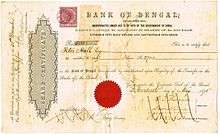Bank of Calcutta
Formerly | Bank of Calcutta |
|---|---|
| Industry | Banking, Financial Services |
| Fate | Merged with Bank of Bombay and Bank of Madras |
| Successor | Imperial Bank of India |
| Founded | 2 June 1806 |
| Defunct | 27 January 1921 |
| Headquarters | Calcutta, Bengal, British India |
Area served | British India |

The Bank of Calcutta (a precursor to the present State Bank of India) was founded on 2 June 1806, mainly to fund General Wellesley's wars against Tipu Sultan and the Marathas. It was the first bank of India and was renamed Bank of Bengal on 2 January 1809.
The bank opened branches at Rangoon (1861), Patna (1862), Mirzapur (1862), and Benares (1862). When it became known that the bank intended to open a branch at Dacca, negotiations began that resulted in Bank of Bengal in 1862 amalgamating Dacca Bank (est. 1846).[1] A branch at Cawnpore followed.
The Bank of Calcutta, and the two other Presidency banks — the Bank of Bombay and the Bank of Madras — amalgamated on 27 January 1921 and the reorganized banking entity assumed the name Imperial Bank of India. The Reserve Bank of India, which is the central banking organization of India, in the year 1955, acquired a controlling interest in the Imperial Bank of India and the Imperial Bank of India was renamed on 30 April 1955 as the State Bank of India.
Citations and references
Citations
- ↑ Banker's Magazine, Vol. 22, p.565-6.
References
- "200 years and going strong". The Tribune. Retrieved 2006-09-08.
Further reading
- Amiya Kumar Bagchi. The Evolution of the State Bank of India. 1 — The Roots 1806-1876. hindu.com.